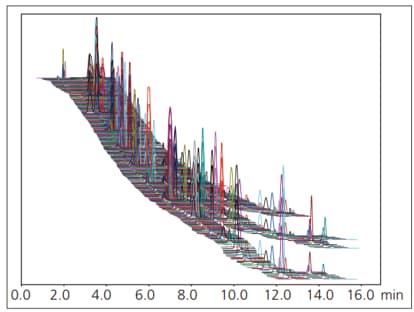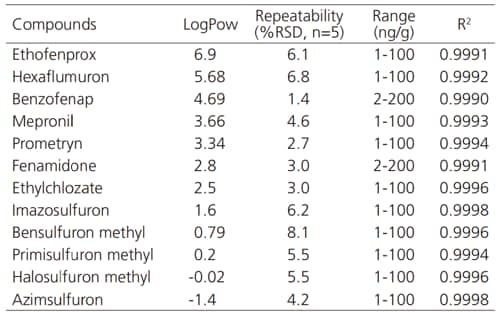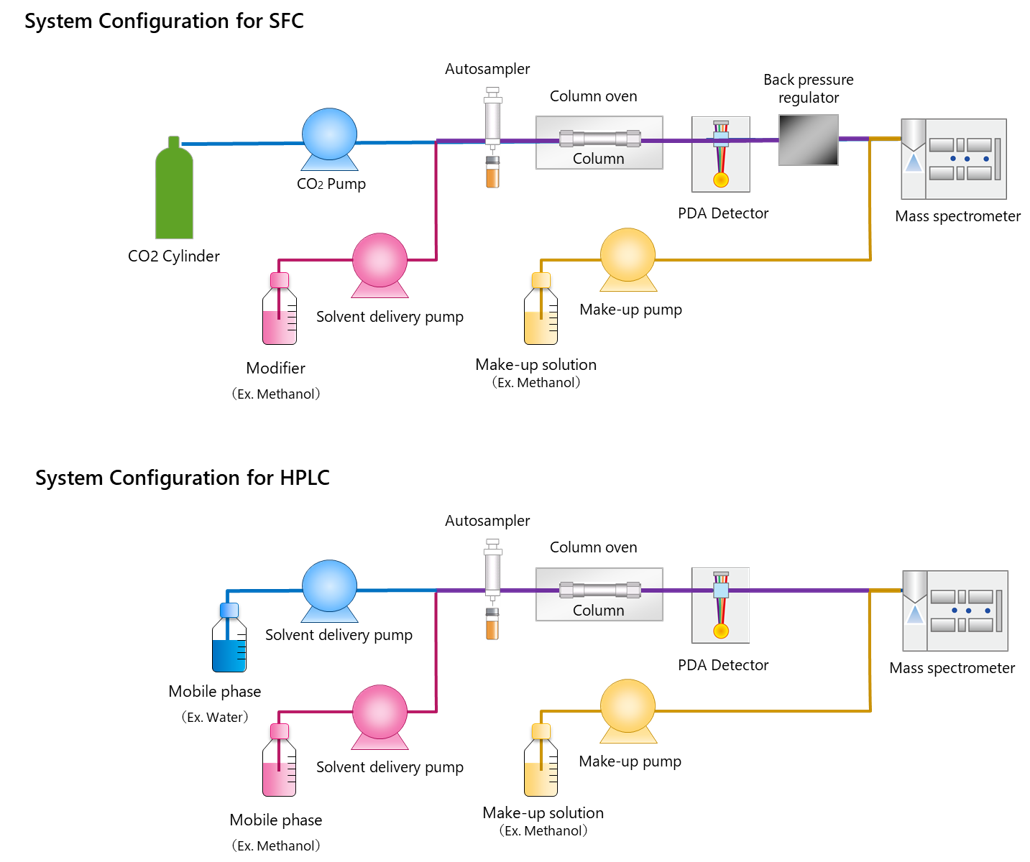What is Supercritical Fluids Chromatography?
What is Supercritical Fluid Chromatography?
Supercritical fluid chromatography (SFC) is a branch of chromatography that yields great results in the field of analytical chemistry. Chromatography is a technique for gaining qualitative and/or quantitative data pertaining to the target compounds. The process involves separating components for detection within two phases – the mobile phase and the stationary phase. Gas chromatography (GC) involves using gas as the mobile phase, while liquid chromatography (LC) employs liquid as the mobile phase. SFC specifically refers to chromatography that uses supercritical fluids, such as carbon dioxide, as the mobile phase. This technique, which is essentially a hybrid of GC and LC, affords high levels of accuracy. The process offers various advantages, including faster analysis times and lower solvent use, which is why SFC systems are widely used in pharmaceutical, food analysis and environmental measurement.
Frequently Asked Questions
How does supercritical fluid chromatography work?
Supercritical fluid chromatography (SFC) is a powerful analytical technique for separating and identifying the components of a sample mixture. The process is as follows:
- The sample is introduced into the mobile phase, which is a supercritical fluid.
- The sample passes through the stationary phase in the column, separating compounds based on their chemical and physical natures.
- The detectors measure the separated compounds for identification and quantification.
More detailed information of SFC is described here.
What is the principle of supercritical fluid?
Supercritical fluids are substances at conditions above their critical temperature and pressure, which means they exhibit properties of both gases and liquids. Their unique chemical properties, including low viscosity, low polarity and high diffusivity, offer a range of possibilities in analytical chemistry. Consequently, they allow highly efficient compound separation, making them ideal for use in chromatography.
What is the instrument for supercritical fluid chromatography?
The main components of an SFC system include the following:
- Pump, which delivers the carbon dioxide used for SFC. The delivery pump must have built-in cooling functionality to keep the carbon dioxide in a liquid state.
- Injector, where the sample mixture is injected into the instrument for analysis. SFC mobile phase is required to dissolve a liquid sample solution, meaning that it is often injected as a liquid and becomes a supercritical state after injection.
- Column, where the separation occurs before compounds can be identified and quantified.
- Detector, which detects separated compounds for quantitation. Back Pressure Regulator, which is installed after the detector to increase and control the back pressure. By applying back pressure, carbon dioxide in the system becomes a supercritical fluid.
SFC systems are incredibly versatile and offer innovations in speed and selectivity, increasing efficiencies in the analysis time and running costs for chromatographic analyses.
What is the difference between SFC and HPLC?
SFC and high-performance liquid chromatography (HPLC) share similar configurations of instruments, but there are a couple of key differences. These include:
- Mobile Phase: SFC uses supercritical fluids like carbon dioxide, while HPLC uses liquid solvents.
- Efficiency: SFC is faster and uses less solvent. This makes SFC a more eco-friendly approach to analysis.
- Applications: SFC excels in analyzing non-polar compounds and unstable compounds that are easily hydrolyzed, while HPLC is versatile for a broader range of polar compounds.
Other differences between high-performance liquid chromatography and supercritical fluid chromatography instrumentation are described here.
What is the application of supercritical fluid chromatography in pharmaceuticals?
SFC is utilized by the pharmaceutical industry for both product development and quality control. The high degree of sensitivity offered by SFC systems makes them a powerful tool for this industry, which also values SFC for its ability to perform chiral separation of enantiomers, highly accurate purity testing of drugs and intermediates, high-through put screening and precise compound screening. The high level of efficiency of SFC makes itself an eco-friendly choice for pharmaceutical analysis.
Find out more about supercritical fluid chromatography applications here.
Why is CO2 used as a mobile phase in supercritical fluid chromatography?
Carbon dioxide is the most commonly used supercritical fluid because of its low critical temperature and pressure. This makes it highly cost-effective and energy-efficient. It’s also non-toxic and recyclable, making it a more sustainable choice for analytical chemistry. It’s also widely used thanks to its inert nature, which means it’s compatible with most analytes.
Chromatography in General
Chromatography is the collective term for various techniques used to separate target components in mixture samples, either chemically or physically, so that they can be qualitatively or quantitatively analyzed, collected, or for other purposes. In chromatography techniques, components are separated within two phases, a mobile phase and a stationary phase. If a gas is used as the mobile phase, the technique is referred to as gas chromatography (GC). If a liquid is used, it is referred to as liquid chromatography (LC). Both GC and LC have become essential techniques for analyzing organic compounds.
LC systems that include a pump for pumping the mobile phase, an autosampler for automatically loading samples, and other devices for increasing performance are referred to as high-performance liquid chromatograph (HPLC) systems. In recent years, there has been increasingly widespread use of ultra high-performance liquid chromatograph (UHPLC) systems. These systems can sustain very high back pressures generated by use of sub 3u particles as stationary phase. However, low particle size results in ultra fast analysis with and sharper peak shapes.
Supercritical Fluid Chromatography
Research on supercritical fluid chromatography (SFC) as an analytical technique began in the 1960s. Typically, SFC refers to chromatographic technique involving using supercritical carbon dioxide as the mobile phase. Since SFC uses CO2 like a liquid, it is also referred to as “LC using CO2.”
Before commercialization of SFC, measuring compounds with a wide range of properties required using multiple analytical techniques, however using a combination of SFC and LC for “unified chromatography” has now enabled simultaneous analysis of heterogeneous components repeating.*1
Fig. 1 shows a simultaneous analysis of 510 standard pesticides in single injection using SFC. Table 1 shows the octanol-water partition coefficient, repeatability, and linearity results for few target pesticides. The technique enables accurate simultaneous analysis of compounds with a wide range of polarities.
-

Fig. 1 Mass Chromatogram of Standard Pesticide Mixture Solution
-
Table 1 Repeatability and Linearity for Pesticide Analysis

Learn more
Instrumentation for Supercritical Fluid Chromatography
SFC systems involve roughly the same configuration of instruments as HPLC systems. Fig. 2 shows a comparison of flow diagrams for SFC and HPLC systems. The four major differences between SFC and HPLC configurations are described below.
- Pumps Designed Specifically for Pumping Supercritical Carbon Dioxide
The carbon dioxide used for SFC is liquified by cooling. Therefore, the delivery pump must have built-in cooling functionality.
- Back Pressure Regulator (BPR)
A unit is required to keep the CO2 in a solvent state (liquid or supercritical fluid) within the system and prevent it from vaporizing by maintaining the pressure level within flow channels. In an SFC system, the BPR unit is positioned downstream from a UV, PDA, or other detector or upstream from an evaporative light scattering detector (ELSD) or mass spectrometer (MS).*2 The BPR unit detects pressure in the flow channels and then rapidly opens and closes valves to maintain a constant pressure within the flow channels.
- Modifier Delivery Pump
For SFC analysis, an organic solvent such as methanol or acetonitrile (modifier) is pumped for mixing with the supercritical carbon dioxide. That means separate pumps are required for pumping the supercritical carbon dioxide and modifier.
- Make-up Delivery Pump
If an ELSD or MS unit is used for detection or if the system is used for preparative separation, then a solvent (make-up solvent) is pumped to prevent precipitation in the flow channels or to improve the recovery rate of components in separated fractions.
Make-up solvent is also pumped to improve sensitivity during MS detection, because supercritical carbon dioxide does not promote ionization.

Fig. 2 Comparison of HPLC and SFC System Configurations
- Simultaneous analysis for water- and fat-soluble vitamins by a novel single chromatography technique unifying supercritical fluid chromatography and liquid chromatography J Chromatogr.A 2014 Oct3; 1362:270-7
- Overview of the retention in subcritical fluid chromatography with varied polarity stationary phases J Sep Sci. 2008 May; 31(8):1238-51






